Managing Continuous Organisational Improvement: Retail Case Study
VerifiedAdded on 2022/11/24
|24
|6025
|162
Report
AI Summary
This report, prepared by a student in the Human Resources Department of Laugfs Holdings Supermarket, a national retail chain in Sri Lanka, analyzes the critical aspects of managing continuous organisational improvement. The report begins by exploring the influence of organisational culture on continuous improvement, highlighting features that encourage change and the implementation of Total Quality Management (TQM) techniques. It then delves into change management approaches, including the Lewin and Kotter models, and identifies the forces driving change within the organisation. The report also addresses approaches to continuous quality improvement, emphasizing the importance of a customer-centric approach and the application of the McKinsey 7S model. The report aims to provide insights into fostering a culture of innovation, overcoming resistance to change, and achieving strategic and operational objectives within a competitive business environment. The student aims to provide insights on how Laugfs Holdings can implement continuous improvement through change management and TQM, fostering a culture of change and innovation to drive business success.
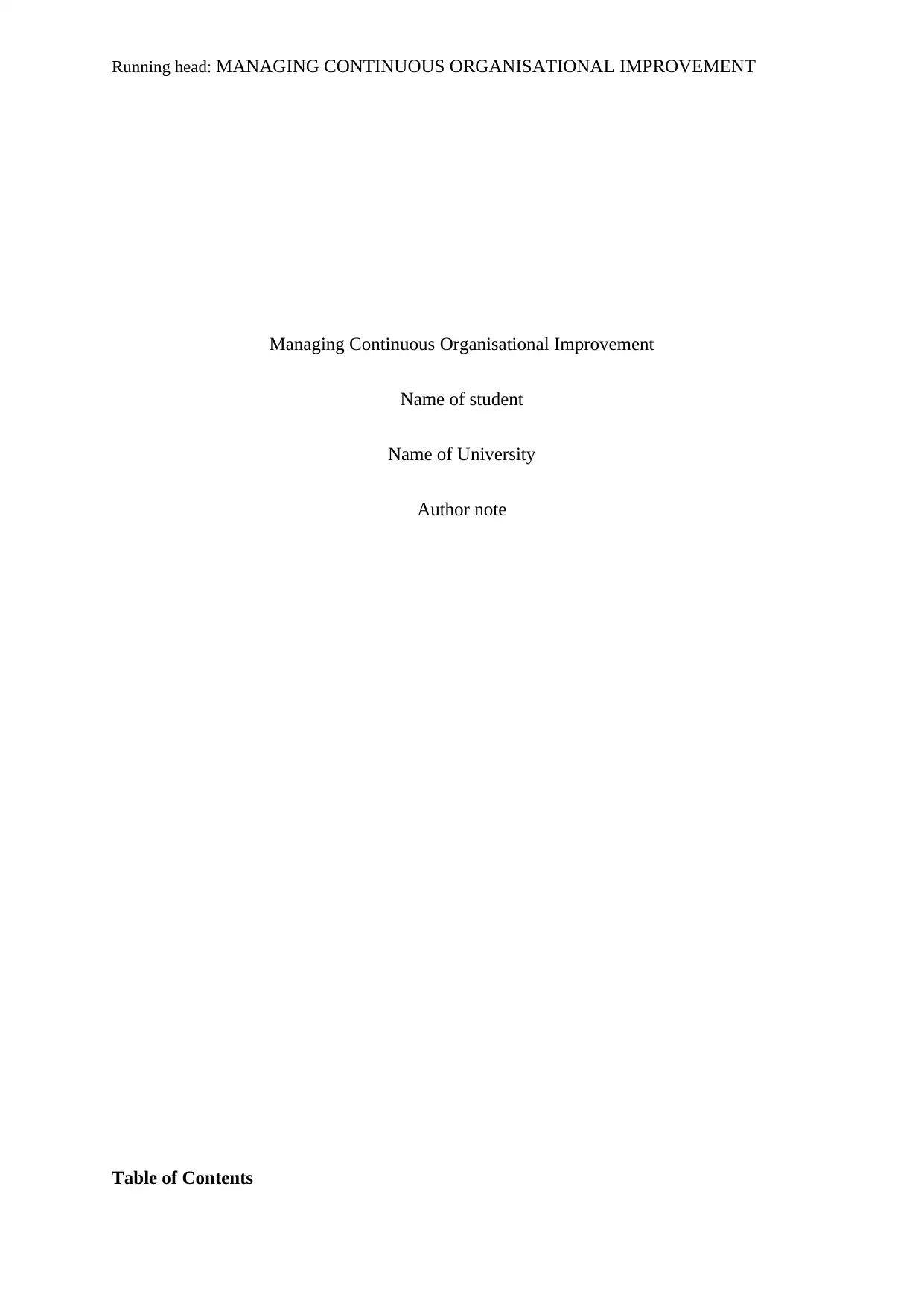
Running head: MANAGING CONTINUOUS ORGANISATIONAL IMPROVEMENT
Managing Continuous Organisational Improvement
Name of student
Name of University
Author note
Table of Contents
Managing Continuous Organisational Improvement
Name of student
Name of University
Author note
Table of Contents
Paraphrase This Document
Need a fresh take? Get an instant paraphrase of this document with our AI Paraphraser
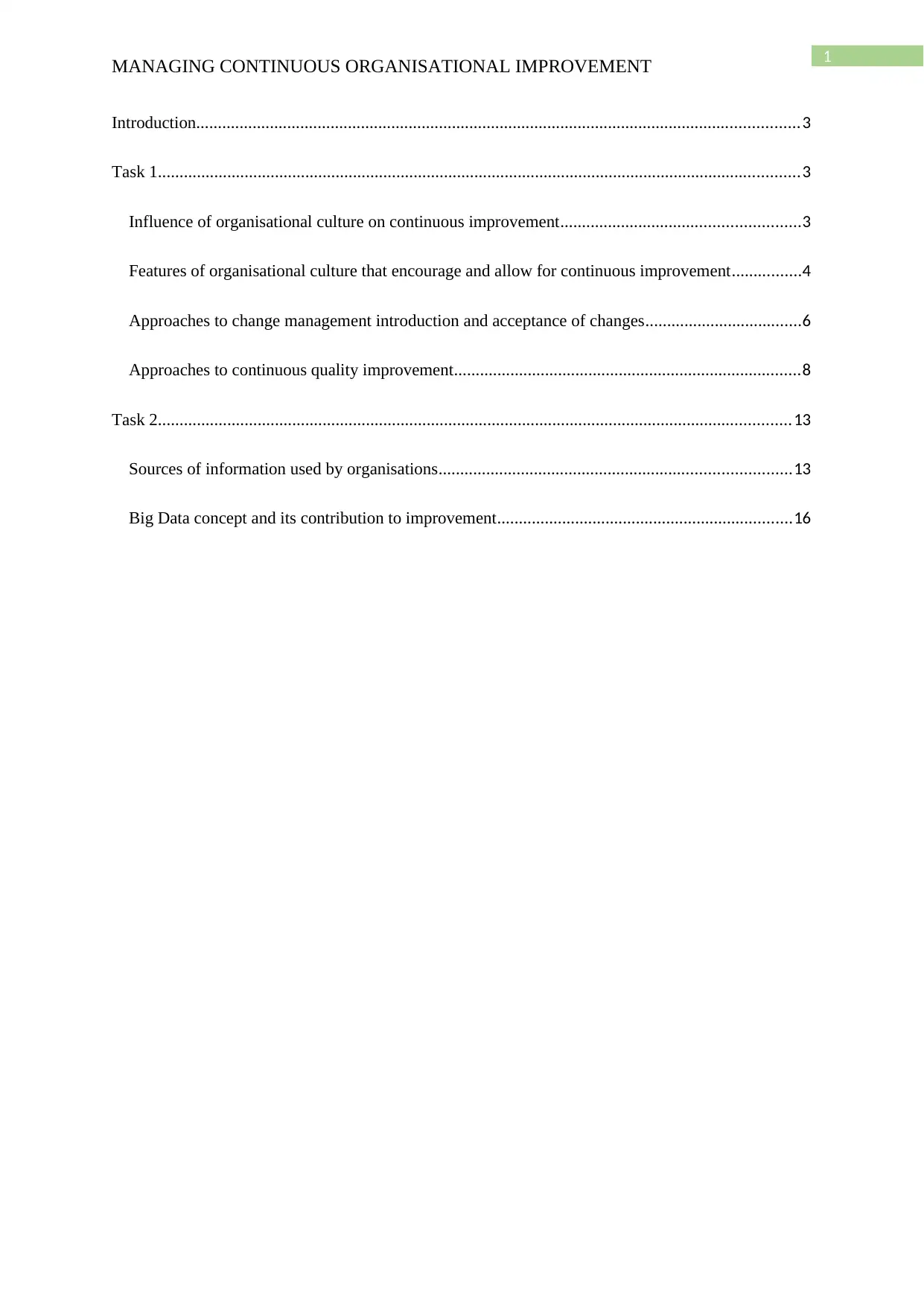
1
MANAGING CONTINUOUS ORGANISATIONAL IMPROVEMENT
Introduction...........................................................................................................................................3
Task 1....................................................................................................................................................3
Influence of organisational culture on continuous improvement.......................................................3
Features of organisational culture that encourage and allow for continuous improvement................4
Approaches to change management introduction and acceptance of changes....................................6
Approaches to continuous quality improvement................................................................................8
Task 2..................................................................................................................................................13
Sources of information used by organisations.................................................................................13
Big Data concept and its contribution to improvement....................................................................16
MANAGING CONTINUOUS ORGANISATIONAL IMPROVEMENT
Introduction...........................................................................................................................................3
Task 1....................................................................................................................................................3
Influence of organisational culture on continuous improvement.......................................................3
Features of organisational culture that encourage and allow for continuous improvement................4
Approaches to change management introduction and acceptance of changes....................................6
Approaches to continuous quality improvement................................................................................8
Task 2..................................................................................................................................................13
Sources of information used by organisations.................................................................................13
Big Data concept and its contribution to improvement....................................................................16
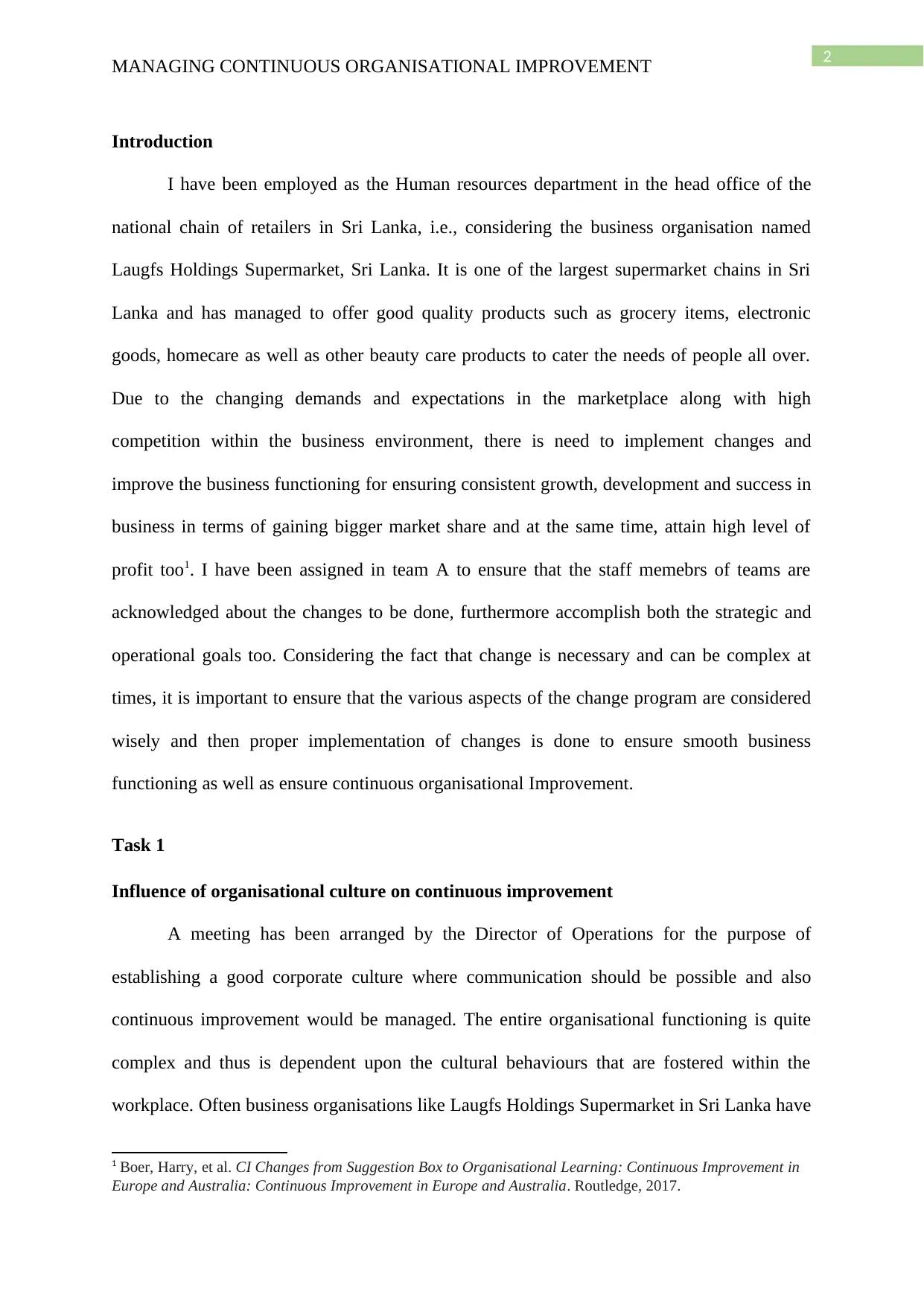
2
MANAGING CONTINUOUS ORGANISATIONAL IMPROVEMENT
Introduction
I have been employed as the Human resources department in the head office of the
national chain of retailers in Sri Lanka, i.e., considering the business organisation named
Laugfs Holdings Supermarket, Sri Lanka. It is one of the largest supermarket chains in Sri
Lanka and has managed to offer good quality products such as grocery items, electronic
goods, homecare as well as other beauty care products to cater the needs of people all over.
Due to the changing demands and expectations in the marketplace along with high
competition within the business environment, there is need to implement changes and
improve the business functioning for ensuring consistent growth, development and success in
business in terms of gaining bigger market share and at the same time, attain high level of
profit too1. I have been assigned in team A to ensure that the staff memebrs of teams are
acknowledged about the changes to be done, furthermore accomplish both the strategic and
operational goals too. Considering the fact that change is necessary and can be complex at
times, it is important to ensure that the various aspects of the change program are considered
wisely and then proper implementation of changes is done to ensure smooth business
functioning as well as ensure continuous organisational Improvement.
Task 1
Influence of organisational culture on continuous improvement
A meeting has been arranged by the Director of Operations for the purpose of
establishing a good corporate culture where communication should be possible and also
continuous improvement would be managed. The entire organisational functioning is quite
complex and thus is dependent upon the cultural behaviours that are fostered within the
workplace. Often business organisations like Laugfs Holdings Supermarket in Sri Lanka have
1 Boer, Harry, et al. CI Changes from Suggestion Box to Organisational Learning: Continuous Improvement in
Europe and Australia: Continuous Improvement in Europe and Australia. Routledge, 2017.
MANAGING CONTINUOUS ORGANISATIONAL IMPROVEMENT
Introduction
I have been employed as the Human resources department in the head office of the
national chain of retailers in Sri Lanka, i.e., considering the business organisation named
Laugfs Holdings Supermarket, Sri Lanka. It is one of the largest supermarket chains in Sri
Lanka and has managed to offer good quality products such as grocery items, electronic
goods, homecare as well as other beauty care products to cater the needs of people all over.
Due to the changing demands and expectations in the marketplace along with high
competition within the business environment, there is need to implement changes and
improve the business functioning for ensuring consistent growth, development and success in
business in terms of gaining bigger market share and at the same time, attain high level of
profit too1. I have been assigned in team A to ensure that the staff memebrs of teams are
acknowledged about the changes to be done, furthermore accomplish both the strategic and
operational goals too. Considering the fact that change is necessary and can be complex at
times, it is important to ensure that the various aspects of the change program are considered
wisely and then proper implementation of changes is done to ensure smooth business
functioning as well as ensure continuous organisational Improvement.
Task 1
Influence of organisational culture on continuous improvement
A meeting has been arranged by the Director of Operations for the purpose of
establishing a good corporate culture where communication should be possible and also
continuous improvement would be managed. The entire organisational functioning is quite
complex and thus is dependent upon the cultural behaviours that are fostered within the
workplace. Often business organisations like Laugfs Holdings Supermarket in Sri Lanka have
1 Boer, Harry, et al. CI Changes from Suggestion Box to Organisational Learning: Continuous Improvement in
Europe and Australia: Continuous Improvement in Europe and Australia. Routledge, 2017.
⊘ This is a preview!⊘
Do you want full access?
Subscribe today to unlock all pages.

Trusted by 1+ million students worldwide
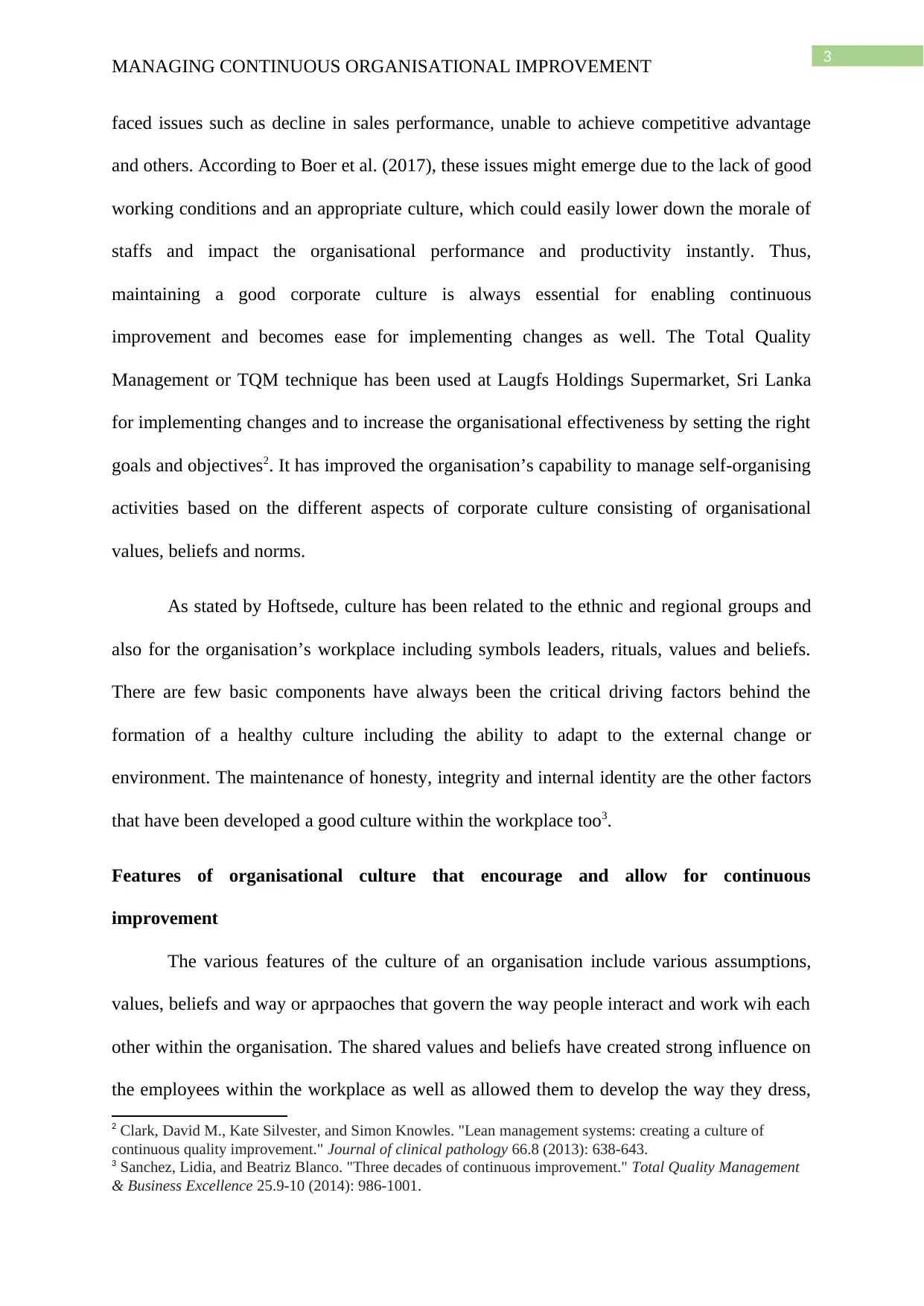
3
MANAGING CONTINUOUS ORGANISATIONAL IMPROVEMENT
faced issues such as decline in sales performance, unable to achieve competitive advantage
and others. According to Boer et al. (2017), these issues might emerge due to the lack of good
working conditions and an appropriate culture, which could easily lower down the morale of
staffs and impact the organisational performance and productivity instantly. Thus,
maintaining a good corporate culture is always essential for enabling continuous
improvement and becomes ease for implementing changes as well. The Total Quality
Management or TQM technique has been used at Laugfs Holdings Supermarket, Sri Lanka
for implementing changes and to increase the organisational effectiveness by setting the right
goals and objectives2. It has improved the organisation’s capability to manage self-organising
activities based on the different aspects of corporate culture consisting of organisational
values, beliefs and norms.
As stated by Hoftsede, culture has been related to the ethnic and regional groups and
also for the organisation’s workplace including symbols leaders, rituals, values and beliefs.
There are few basic components have always been the critical driving factors behind the
formation of a healthy culture including the ability to adapt to the external change or
environment. The maintenance of honesty, integrity and internal identity are the other factors
that have been developed a good culture within the workplace too3.
Features of organisational culture that encourage and allow for continuous
improvement
The various features of the culture of an organisation include various assumptions,
values, beliefs and way or aprpaoches that govern the way people interact and work wih each
other within the organisation. The shared values and beliefs have created strong influence on
the employees within the workplace as well as allowed them to develop the way they dress,
2 Clark, David M., Kate Silvester, and Simon Knowles. "Lean management systems: creating a culture of
continuous quality improvement." Journal of clinical pathology 66.8 (2013): 638-643.
3 Sanchez, Lidia, and Beatriz Blanco. "Three decades of continuous improvement." Total Quality Management
& Business Excellence 25.9-10 (2014): 986-1001.
MANAGING CONTINUOUS ORGANISATIONAL IMPROVEMENT
faced issues such as decline in sales performance, unable to achieve competitive advantage
and others. According to Boer et al. (2017), these issues might emerge due to the lack of good
working conditions and an appropriate culture, which could easily lower down the morale of
staffs and impact the organisational performance and productivity instantly. Thus,
maintaining a good corporate culture is always essential for enabling continuous
improvement and becomes ease for implementing changes as well. The Total Quality
Management or TQM technique has been used at Laugfs Holdings Supermarket, Sri Lanka
for implementing changes and to increase the organisational effectiveness by setting the right
goals and objectives2. It has improved the organisation’s capability to manage self-organising
activities based on the different aspects of corporate culture consisting of organisational
values, beliefs and norms.
As stated by Hoftsede, culture has been related to the ethnic and regional groups and
also for the organisation’s workplace including symbols leaders, rituals, values and beliefs.
There are few basic components have always been the critical driving factors behind the
formation of a healthy culture including the ability to adapt to the external change or
environment. The maintenance of honesty, integrity and internal identity are the other factors
that have been developed a good culture within the workplace too3.
Features of organisational culture that encourage and allow for continuous
improvement
The various features of the culture of an organisation include various assumptions,
values, beliefs and way or aprpaoches that govern the way people interact and work wih each
other within the organisation. The shared values and beliefs have created strong influence on
the employees within the workplace as well as allowed them to develop the way they dress,
2 Clark, David M., Kate Silvester, and Simon Knowles. "Lean management systems: creating a culture of
continuous quality improvement." Journal of clinical pathology 66.8 (2013): 638-643.
3 Sanchez, Lidia, and Beatriz Blanco. "Three decades of continuous improvement." Total Quality Management
& Business Excellence 25.9-10 (2014): 986-1001.
Paraphrase This Document
Need a fresh take? Get an instant paraphrase of this document with our AI Paraphraser
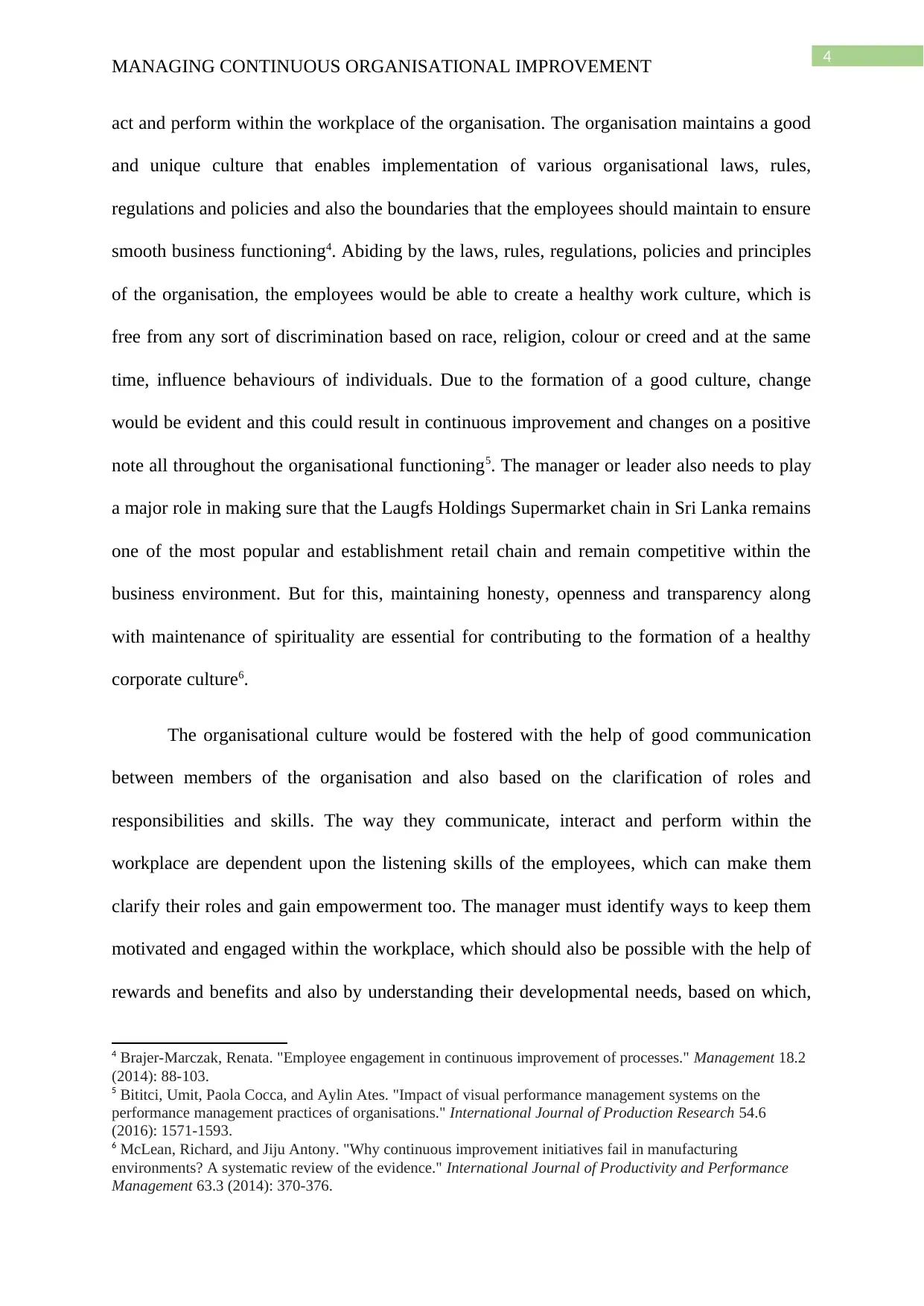
4
MANAGING CONTINUOUS ORGANISATIONAL IMPROVEMENT
act and perform within the workplace of the organisation. The organisation maintains a good
and unique culture that enables implementation of various organisational laws, rules,
regulations and policies and also the boundaries that the employees should maintain to ensure
smooth business functioning4. Abiding by the laws, rules, regulations, policies and principles
of the organisation, the employees would be able to create a healthy work culture, which is
free from any sort of discrimination based on race, religion, colour or creed and at the same
time, influence behaviours of individuals. Due to the formation of a good culture, change
would be evident and this could result in continuous improvement and changes on a positive
note all throughout the organisational functioning5. The manager or leader also needs to play
a major role in making sure that the Laugfs Holdings Supermarket chain in Sri Lanka remains
one of the most popular and establishment retail chain and remain competitive within the
business environment. But for this, maintaining honesty, openness and transparency along
with maintenance of spirituality are essential for contributing to the formation of a healthy
corporate culture6.
The organisational culture would be fostered with the help of good communication
between members of the organisation and also based on the clarification of roles and
responsibilities and skills. The way they communicate, interact and perform within the
workplace are dependent upon the listening skills of the employees, which can make them
clarify their roles and gain empowerment too. The manager must identify ways to keep them
motivated and engaged within the workplace, which should also be possible with the help of
rewards and benefits and also by understanding their developmental needs, based on which,
4 Brajer-Marczak, Renata. "Employee engagement in continuous improvement of processes." Management 18.2
(2014): 88-103.
5 Bititci, Umit, Paola Cocca, and Aylin Ates. "Impact of visual performance management systems on the
performance management practices of organisations." International Journal of Production Research 54.6
(2016): 1571-1593.
6 McLean, Richard, and Jiju Antony. "Why continuous improvement initiatives fail in manufacturing
environments? A systematic review of the evidence." International Journal of Productivity and Performance
Management 63.3 (2014): 370-376.
MANAGING CONTINUOUS ORGANISATIONAL IMPROVEMENT
act and perform within the workplace of the organisation. The organisation maintains a good
and unique culture that enables implementation of various organisational laws, rules,
regulations and policies and also the boundaries that the employees should maintain to ensure
smooth business functioning4. Abiding by the laws, rules, regulations, policies and principles
of the organisation, the employees would be able to create a healthy work culture, which is
free from any sort of discrimination based on race, religion, colour or creed and at the same
time, influence behaviours of individuals. Due to the formation of a good culture, change
would be evident and this could result in continuous improvement and changes on a positive
note all throughout the organisational functioning5. The manager or leader also needs to play
a major role in making sure that the Laugfs Holdings Supermarket chain in Sri Lanka remains
one of the most popular and establishment retail chain and remain competitive within the
business environment. But for this, maintaining honesty, openness and transparency along
with maintenance of spirituality are essential for contributing to the formation of a healthy
corporate culture6.
The organisational culture would be fostered with the help of good communication
between members of the organisation and also based on the clarification of roles and
responsibilities and skills. The way they communicate, interact and perform within the
workplace are dependent upon the listening skills of the employees, which can make them
clarify their roles and gain empowerment too. The manager must identify ways to keep them
motivated and engaged within the workplace, which should also be possible with the help of
rewards and benefits and also by understanding their developmental needs, based on which,
4 Brajer-Marczak, Renata. "Employee engagement in continuous improvement of processes." Management 18.2
(2014): 88-103.
5 Bititci, Umit, Paola Cocca, and Aylin Ates. "Impact of visual performance management systems on the
performance management practices of organisations." International Journal of Production Research 54.6
(2016): 1571-1593.
6 McLean, Richard, and Jiju Antony. "Why continuous improvement initiatives fail in manufacturing
environments? A systematic review of the evidence." International Journal of Productivity and Performance
Management 63.3 (2014): 370-376.
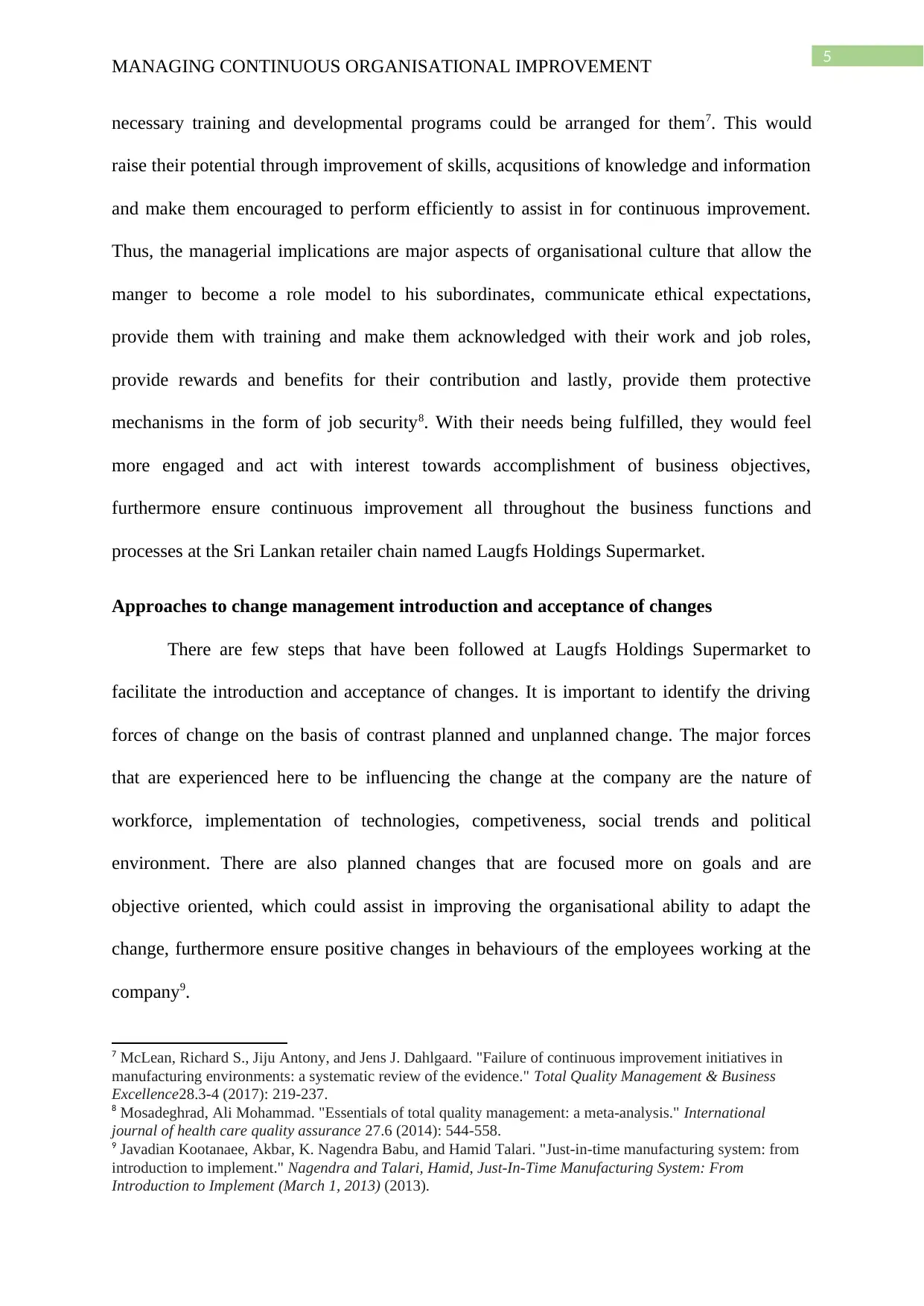
5
MANAGING CONTINUOUS ORGANISATIONAL IMPROVEMENT
necessary training and developmental programs could be arranged for them7. This would
raise their potential through improvement of skills, acqusitions of knowledge and information
and make them encouraged to perform efficiently to assist in for continuous improvement.
Thus, the managerial implications are major aspects of organisational culture that allow the
manger to become a role model to his subordinates, communicate ethical expectations,
provide them with training and make them acknowledged with their work and job roles,
provide rewards and benefits for their contribution and lastly, provide them protective
mechanisms in the form of job security8. With their needs being fulfilled, they would feel
more engaged and act with interest towards accomplishment of business objectives,
furthermore ensure continuous improvement all throughout the business functions and
processes at the Sri Lankan retailer chain named Laugfs Holdings Supermarket.
Approaches to change management introduction and acceptance of changes
There are few steps that have been followed at Laugfs Holdings Supermarket to
facilitate the introduction and acceptance of changes. It is important to identify the driving
forces of change on the basis of contrast planned and unplanned change. The major forces
that are experienced here to be influencing the change at the company are the nature of
workforce, implementation of technologies, competiveness, social trends and political
environment. There are also planned changes that are focused more on goals and are
objective oriented, which could assist in improving the organisational ability to adapt the
change, furthermore ensure positive changes in behaviours of the employees working at the
company9.
7 McLean, Richard S., Jiju Antony, and Jens J. Dahlgaard. "Failure of continuous improvement initiatives in
manufacturing environments: a systematic review of the evidence." Total Quality Management & Business
Excellence28.3-4 (2017): 219-237.
8 Mosadeghrad, Ali Mohammad. "Essentials of total quality management: a meta-analysis." International
journal of health care quality assurance 27.6 (2014): 544-558.
9 Javadian Kootanaee, Akbar, K. Nagendra Babu, and Hamid Talari. "Just-in-time manufacturing system: from
introduction to implement." Nagendra and Talari, Hamid, Just-In-Time Manufacturing System: From
Introduction to Implement (March 1, 2013) (2013).
MANAGING CONTINUOUS ORGANISATIONAL IMPROVEMENT
necessary training and developmental programs could be arranged for them7. This would
raise their potential through improvement of skills, acqusitions of knowledge and information
and make them encouraged to perform efficiently to assist in for continuous improvement.
Thus, the managerial implications are major aspects of organisational culture that allow the
manger to become a role model to his subordinates, communicate ethical expectations,
provide them with training and make them acknowledged with their work and job roles,
provide rewards and benefits for their contribution and lastly, provide them protective
mechanisms in the form of job security8. With their needs being fulfilled, they would feel
more engaged and act with interest towards accomplishment of business objectives,
furthermore ensure continuous improvement all throughout the business functions and
processes at the Sri Lankan retailer chain named Laugfs Holdings Supermarket.
Approaches to change management introduction and acceptance of changes
There are few steps that have been followed at Laugfs Holdings Supermarket to
facilitate the introduction and acceptance of changes. It is important to identify the driving
forces of change on the basis of contrast planned and unplanned change. The major forces
that are experienced here to be influencing the change at the company are the nature of
workforce, implementation of technologies, competiveness, social trends and political
environment. There are also planned changes that are focused more on goals and are
objective oriented, which could assist in improving the organisational ability to adapt the
change, furthermore ensure positive changes in behaviours of the employees working at the
company9.
7 McLean, Richard S., Jiju Antony, and Jens J. Dahlgaard. "Failure of continuous improvement initiatives in
manufacturing environments: a systematic review of the evidence." Total Quality Management & Business
Excellence28.3-4 (2017): 219-237.
8 Mosadeghrad, Ali Mohammad. "Essentials of total quality management: a meta-analysis." International
journal of health care quality assurance 27.6 (2014): 544-558.
9 Javadian Kootanaee, Akbar, K. Nagendra Babu, and Hamid Talari. "Just-in-time manufacturing system: from
introduction to implement." Nagendra and Talari, Hamid, Just-In-Time Manufacturing System: From
Introduction to Implement (March 1, 2013) (2013).
⊘ This is a preview!⊘
Do you want full access?
Subscribe today to unlock all pages.

Trusted by 1+ million students worldwide
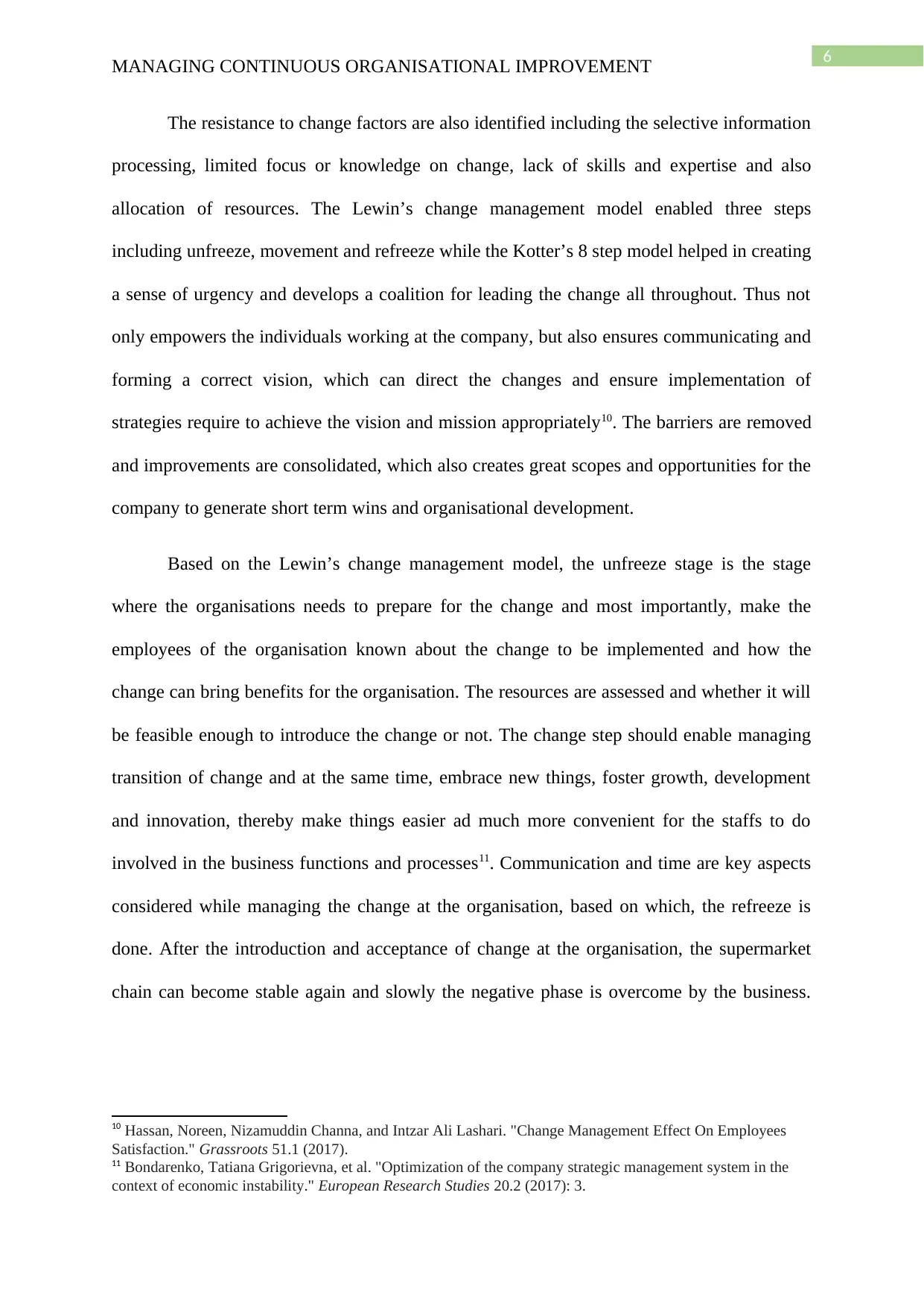
6
MANAGING CONTINUOUS ORGANISATIONAL IMPROVEMENT
The resistance to change factors are also identified including the selective information
processing, limited focus or knowledge on change, lack of skills and expertise and also
allocation of resources. The Lewin’s change management model enabled three steps
including unfreeze, movement and refreeze while the Kotter’s 8 step model helped in creating
a sense of urgency and develops a coalition for leading the change all throughout. Thus not
only empowers the individuals working at the company, but also ensures communicating and
forming a correct vision, which can direct the changes and ensure implementation of
strategies require to achieve the vision and mission appropriately10. The barriers are removed
and improvements are consolidated, which also creates great scopes and opportunities for the
company to generate short term wins and organisational development.
Based on the Lewin’s change management model, the unfreeze stage is the stage
where the organisations needs to prepare for the change and most importantly, make the
employees of the organisation known about the change to be implemented and how the
change can bring benefits for the organisation. The resources are assessed and whether it will
be feasible enough to introduce the change or not. The change step should enable managing
transition of change and at the same time, embrace new things, foster growth, development
and innovation, thereby make things easier ad much more convenient for the staffs to do
involved in the business functions and processes11. Communication and time are key aspects
considered while managing the change at the organisation, based on which, the refreeze is
done. After the introduction and acceptance of change at the organisation, the supermarket
chain can become stable again and slowly the negative phase is overcome by the business.
10 Hassan, Noreen, Nizamuddin Channa, and Intzar Ali Lashari. "Change Management Effect On Employees
Satisfaction." Grassroots 51.1 (2017).
11 Bondarenko, Tatiana Grigorievna, et al. "Optimization of the company strategic management system in the
context of economic instability." European Research Studies 20.2 (2017): 3.
MANAGING CONTINUOUS ORGANISATIONAL IMPROVEMENT
The resistance to change factors are also identified including the selective information
processing, limited focus or knowledge on change, lack of skills and expertise and also
allocation of resources. The Lewin’s change management model enabled three steps
including unfreeze, movement and refreeze while the Kotter’s 8 step model helped in creating
a sense of urgency and develops a coalition for leading the change all throughout. Thus not
only empowers the individuals working at the company, but also ensures communicating and
forming a correct vision, which can direct the changes and ensure implementation of
strategies require to achieve the vision and mission appropriately10. The barriers are removed
and improvements are consolidated, which also creates great scopes and opportunities for the
company to generate short term wins and organisational development.
Based on the Lewin’s change management model, the unfreeze stage is the stage
where the organisations needs to prepare for the change and most importantly, make the
employees of the organisation known about the change to be implemented and how the
change can bring benefits for the organisation. The resources are assessed and whether it will
be feasible enough to introduce the change or not. The change step should enable managing
transition of change and at the same time, embrace new things, foster growth, development
and innovation, thereby make things easier ad much more convenient for the staffs to do
involved in the business functions and processes11. Communication and time are key aspects
considered while managing the change at the organisation, based on which, the refreeze is
done. After the introduction and acceptance of change at the organisation, the supermarket
chain can become stable again and slowly the negative phase is overcome by the business.
10 Hassan, Noreen, Nizamuddin Channa, and Intzar Ali Lashari. "Change Management Effect On Employees
Satisfaction." Grassroots 51.1 (2017).
11 Bondarenko, Tatiana Grigorievna, et al. "Optimization of the company strategic management system in the
context of economic instability." European Research Studies 20.2 (2017): 3.
Paraphrase This Document
Need a fresh take? Get an instant paraphrase of this document with our AI Paraphraser
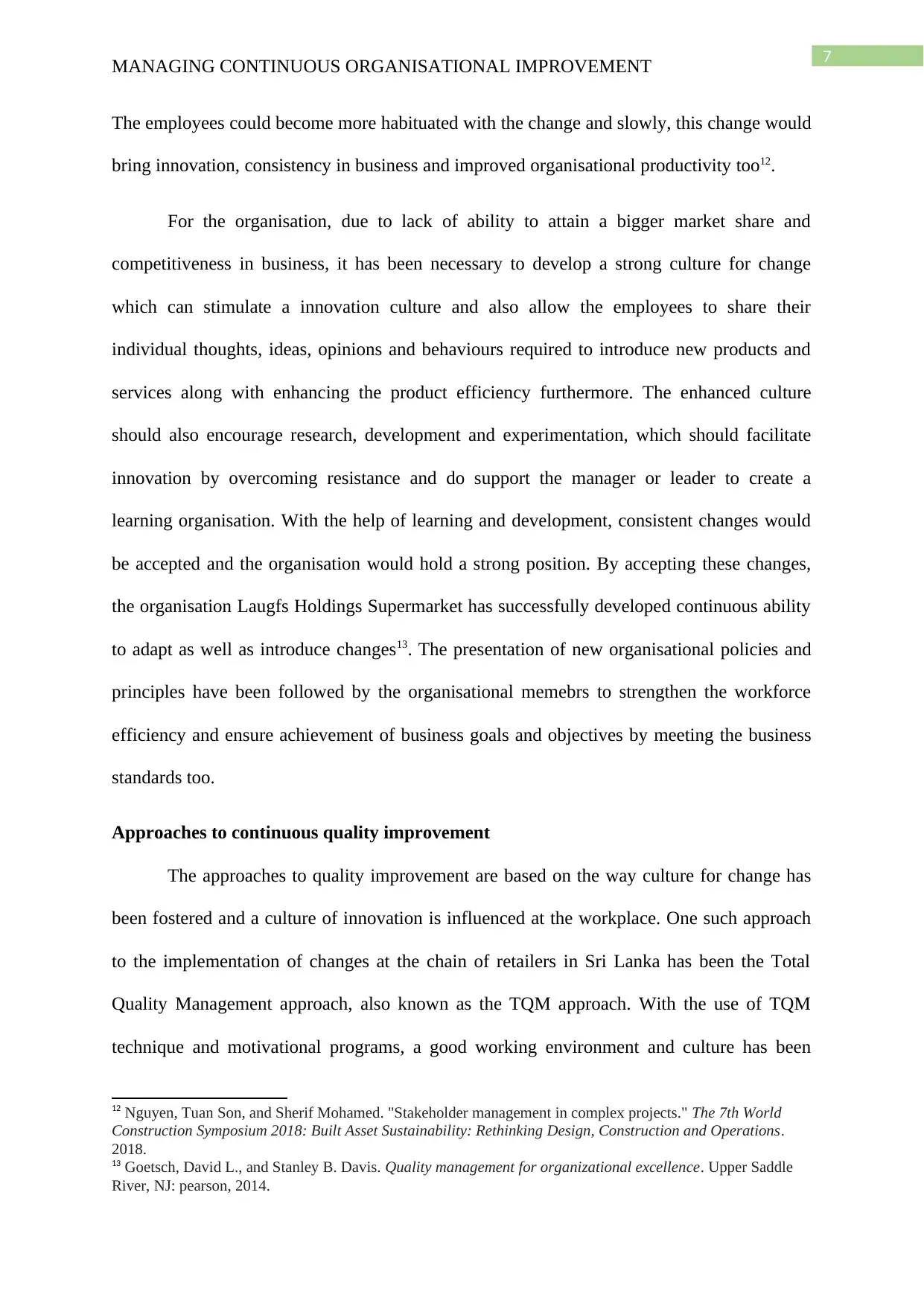
7
MANAGING CONTINUOUS ORGANISATIONAL IMPROVEMENT
The employees could become more habituated with the change and slowly, this change would
bring innovation, consistency in business and improved organisational productivity too12.
For the organisation, due to lack of ability to attain a bigger market share and
competitiveness in business, it has been necessary to develop a strong culture for change
which can stimulate a innovation culture and also allow the employees to share their
individual thoughts, ideas, opinions and behaviours required to introduce new products and
services along with enhancing the product efficiency furthermore. The enhanced culture
should also encourage research, development and experimentation, which should facilitate
innovation by overcoming resistance and do support the manager or leader to create a
learning organisation. With the help of learning and development, consistent changes would
be accepted and the organisation would hold a strong position. By accepting these changes,
the organisation Laugfs Holdings Supermarket has successfully developed continuous ability
to adapt as well as introduce changes13. The presentation of new organisational policies and
principles have been followed by the organisational memebrs to strengthen the workforce
efficiency and ensure achievement of business goals and objectives by meeting the business
standards too.
Approaches to continuous quality improvement
The approaches to quality improvement are based on the way culture for change has
been fostered and a culture of innovation is influenced at the workplace. One such approach
to the implementation of changes at the chain of retailers in Sri Lanka has been the Total
Quality Management approach, also known as the TQM approach. With the use of TQM
technique and motivational programs, a good working environment and culture has been
12 Nguyen, Tuan Son, and Sherif Mohamed. "Stakeholder management in complex projects." The 7th World
Construction Symposium 2018: Built Asset Sustainability: Rethinking Design, Construction and Operations.
2018.
13 Goetsch, David L., and Stanley B. Davis. Quality management for organizational excellence. Upper Saddle
River, NJ: pearson, 2014.
MANAGING CONTINUOUS ORGANISATIONAL IMPROVEMENT
The employees could become more habituated with the change and slowly, this change would
bring innovation, consistency in business and improved organisational productivity too12.
For the organisation, due to lack of ability to attain a bigger market share and
competitiveness in business, it has been necessary to develop a strong culture for change
which can stimulate a innovation culture and also allow the employees to share their
individual thoughts, ideas, opinions and behaviours required to introduce new products and
services along with enhancing the product efficiency furthermore. The enhanced culture
should also encourage research, development and experimentation, which should facilitate
innovation by overcoming resistance and do support the manager or leader to create a
learning organisation. With the help of learning and development, consistent changes would
be accepted and the organisation would hold a strong position. By accepting these changes,
the organisation Laugfs Holdings Supermarket has successfully developed continuous ability
to adapt as well as introduce changes13. The presentation of new organisational policies and
principles have been followed by the organisational memebrs to strengthen the workforce
efficiency and ensure achievement of business goals and objectives by meeting the business
standards too.
Approaches to continuous quality improvement
The approaches to quality improvement are based on the way culture for change has
been fostered and a culture of innovation is influenced at the workplace. One such approach
to the implementation of changes at the chain of retailers in Sri Lanka has been the Total
Quality Management approach, also known as the TQM approach. With the use of TQM
technique and motivational programs, a good working environment and culture has been
12 Nguyen, Tuan Son, and Sherif Mohamed. "Stakeholder management in complex projects." The 7th World
Construction Symposium 2018: Built Asset Sustainability: Rethinking Design, Construction and Operations.
2018.
13 Goetsch, David L., and Stanley B. Davis. Quality management for organizational excellence. Upper Saddle
River, NJ: pearson, 2014.
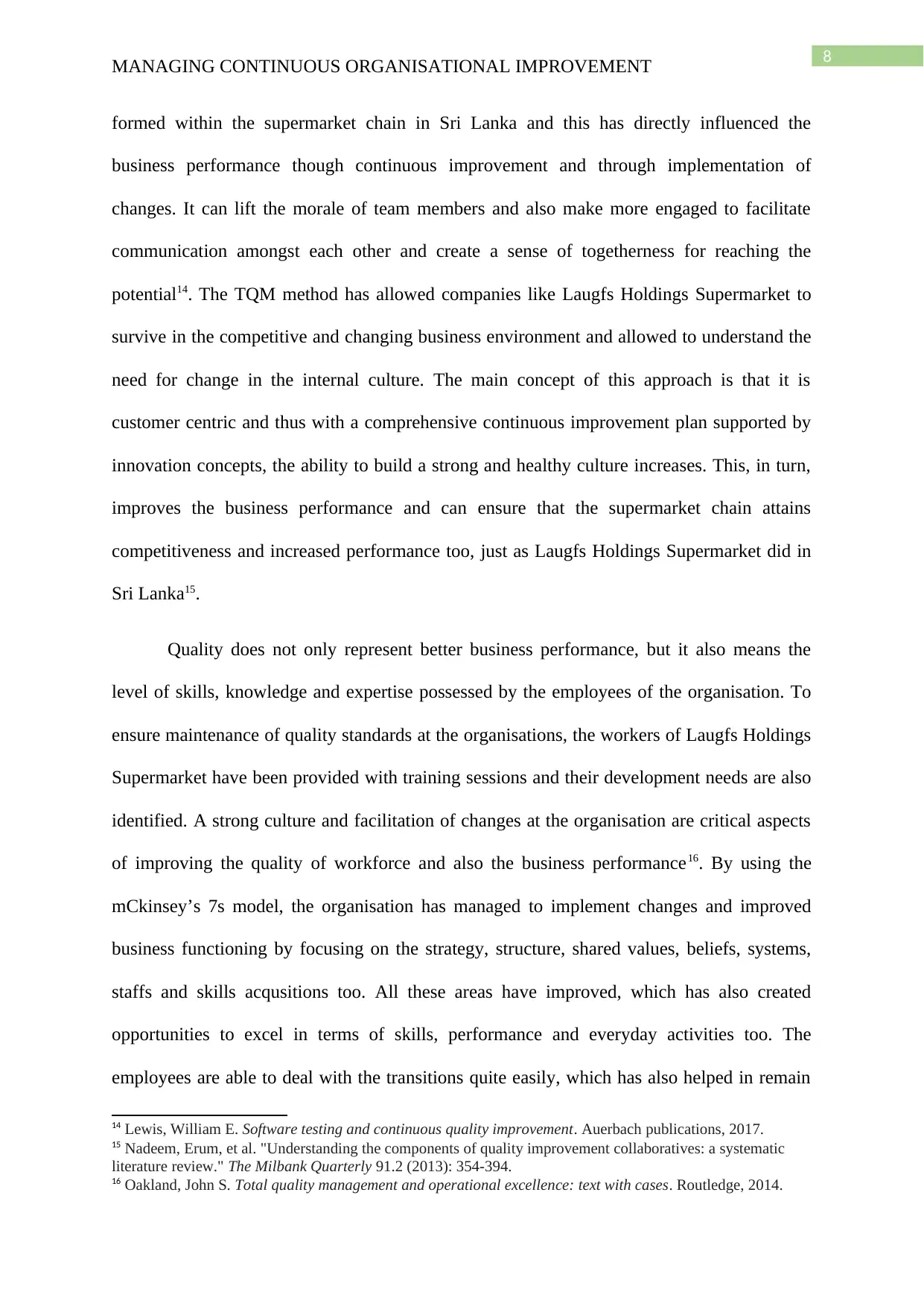
8
MANAGING CONTINUOUS ORGANISATIONAL IMPROVEMENT
formed within the supermarket chain in Sri Lanka and this has directly influenced the
business performance though continuous improvement and through implementation of
changes. It can lift the morale of team members and also make more engaged to facilitate
communication amongst each other and create a sense of togetherness for reaching the
potential14. The TQM method has allowed companies like Laugfs Holdings Supermarket to
survive in the competitive and changing business environment and allowed to understand the
need for change in the internal culture. The main concept of this approach is that it is
customer centric and thus with a comprehensive continuous improvement plan supported by
innovation concepts, the ability to build a strong and healthy culture increases. This, in turn,
improves the business performance and can ensure that the supermarket chain attains
competitiveness and increased performance too, just as Laugfs Holdings Supermarket did in
Sri Lanka15.
Quality does not only represent better business performance, but it also means the
level of skills, knowledge and expertise possessed by the employees of the organisation. To
ensure maintenance of quality standards at the organisations, the workers of Laugfs Holdings
Supermarket have been provided with training sessions and their development needs are also
identified. A strong culture and facilitation of changes at the organisation are critical aspects
of improving the quality of workforce and also the business performance16. By using the
mCkinsey’s 7s model, the organisation has managed to implement changes and improved
business functioning by focusing on the strategy, structure, shared values, beliefs, systems,
staffs and skills acqusitions too. All these areas have improved, which has also created
opportunities to excel in terms of skills, performance and everyday activities too. The
employees are able to deal with the transitions quite easily, which has also helped in remain
14 Lewis, William E. Software testing and continuous quality improvement. Auerbach publications, 2017.
15 Nadeem, Erum, et al. "Understanding the components of quality improvement collaboratives: a systematic
literature review." The Milbank Quarterly 91.2 (2013): 354-394.
16 Oakland, John S. Total quality management and operational excellence: text with cases. Routledge, 2014.
MANAGING CONTINUOUS ORGANISATIONAL IMPROVEMENT
formed within the supermarket chain in Sri Lanka and this has directly influenced the
business performance though continuous improvement and through implementation of
changes. It can lift the morale of team members and also make more engaged to facilitate
communication amongst each other and create a sense of togetherness for reaching the
potential14. The TQM method has allowed companies like Laugfs Holdings Supermarket to
survive in the competitive and changing business environment and allowed to understand the
need for change in the internal culture. The main concept of this approach is that it is
customer centric and thus with a comprehensive continuous improvement plan supported by
innovation concepts, the ability to build a strong and healthy culture increases. This, in turn,
improves the business performance and can ensure that the supermarket chain attains
competitiveness and increased performance too, just as Laugfs Holdings Supermarket did in
Sri Lanka15.
Quality does not only represent better business performance, but it also means the
level of skills, knowledge and expertise possessed by the employees of the organisation. To
ensure maintenance of quality standards at the organisations, the workers of Laugfs Holdings
Supermarket have been provided with training sessions and their development needs are also
identified. A strong culture and facilitation of changes at the organisation are critical aspects
of improving the quality of workforce and also the business performance16. By using the
mCkinsey’s 7s model, the organisation has managed to implement changes and improved
business functioning by focusing on the strategy, structure, shared values, beliefs, systems,
staffs and skills acqusitions too. All these areas have improved, which has also created
opportunities to excel in terms of skills, performance and everyday activities too. The
employees are able to deal with the transitions quite easily, which has also helped in remain
14 Lewis, William E. Software testing and continuous quality improvement. Auerbach publications, 2017.
15 Nadeem, Erum, et al. "Understanding the components of quality improvement collaboratives: a systematic
literature review." The Milbank Quarterly 91.2 (2013): 354-394.
16 Oakland, John S. Total quality management and operational excellence: text with cases. Routledge, 2014.
⊘ This is a preview!⊘
Do you want full access?
Subscribe today to unlock all pages.

Trusted by 1+ million students worldwide
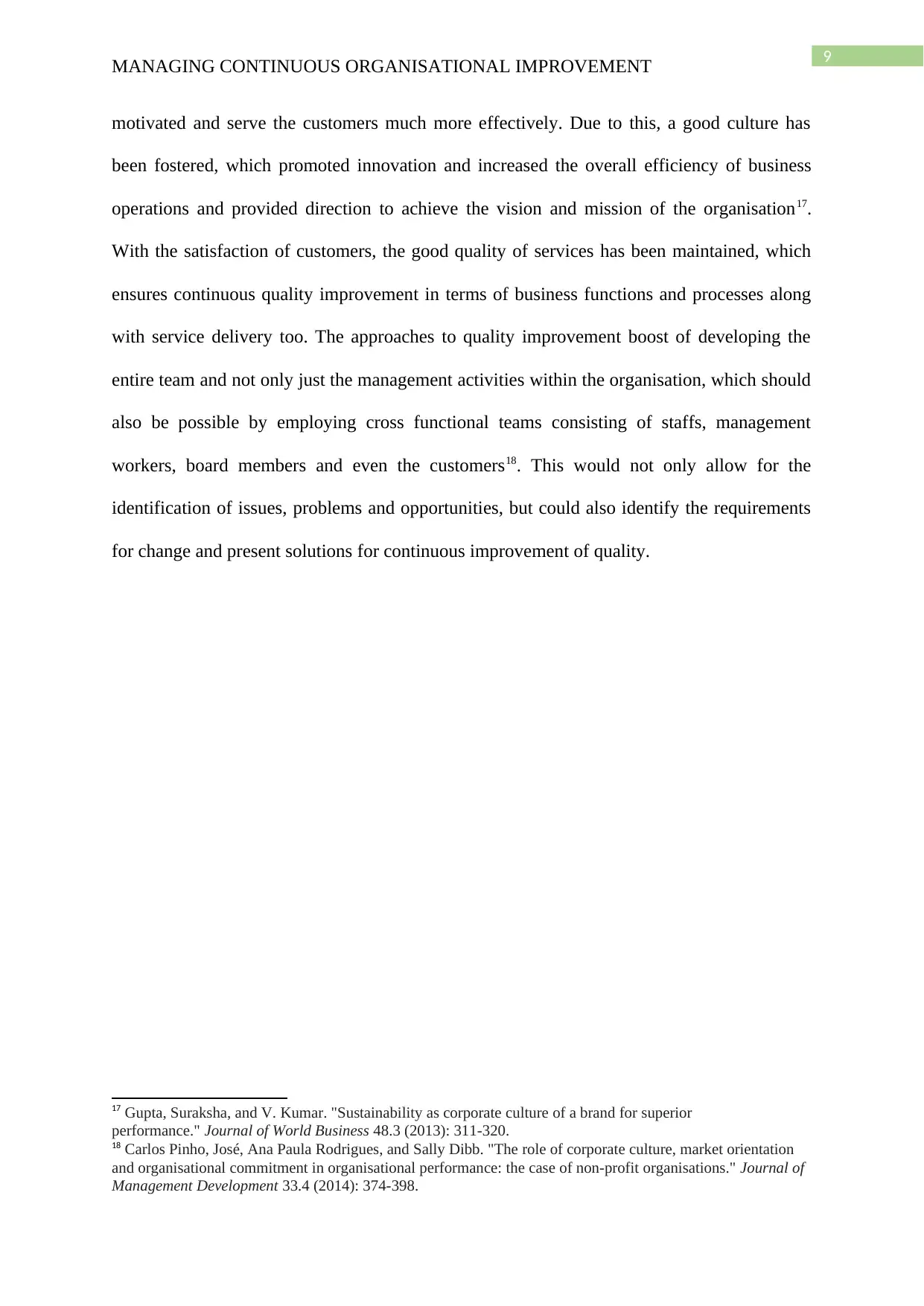
9
MANAGING CONTINUOUS ORGANISATIONAL IMPROVEMENT
motivated and serve the customers much more effectively. Due to this, a good culture has
been fostered, which promoted innovation and increased the overall efficiency of business
operations and provided direction to achieve the vision and mission of the organisation17.
With the satisfaction of customers, the good quality of services has been maintained, which
ensures continuous quality improvement in terms of business functions and processes along
with service delivery too. The approaches to quality improvement boost of developing the
entire team and not only just the management activities within the organisation, which should
also be possible by employing cross functional teams consisting of staffs, management
workers, board members and even the customers18. This would not only allow for the
identification of issues, problems and opportunities, but could also identify the requirements
for change and present solutions for continuous improvement of quality.
17 Gupta, Suraksha, and V. Kumar. "Sustainability as corporate culture of a brand for superior
performance." Journal of World Business 48.3 (2013): 311-320.
18 Carlos Pinho, José, Ana Paula Rodrigues, and Sally Dibb. "The role of corporate culture, market orientation
and organisational commitment in organisational performance: the case of non-profit organisations." Journal of
Management Development 33.4 (2014): 374-398.
MANAGING CONTINUOUS ORGANISATIONAL IMPROVEMENT
motivated and serve the customers much more effectively. Due to this, a good culture has
been fostered, which promoted innovation and increased the overall efficiency of business
operations and provided direction to achieve the vision and mission of the organisation17.
With the satisfaction of customers, the good quality of services has been maintained, which
ensures continuous quality improvement in terms of business functions and processes along
with service delivery too. The approaches to quality improvement boost of developing the
entire team and not only just the management activities within the organisation, which should
also be possible by employing cross functional teams consisting of staffs, management
workers, board members and even the customers18. This would not only allow for the
identification of issues, problems and opportunities, but could also identify the requirements
for change and present solutions for continuous improvement of quality.
17 Gupta, Suraksha, and V. Kumar. "Sustainability as corporate culture of a brand for superior
performance." Journal of World Business 48.3 (2013): 311-320.
18 Carlos Pinho, José, Ana Paula Rodrigues, and Sally Dibb. "The role of corporate culture, market orientation
and organisational commitment in organisational performance: the case of non-profit organisations." Journal of
Management Development 33.4 (2014): 374-398.
Paraphrase This Document
Need a fresh take? Get an instant paraphrase of this document with our AI Paraphraser
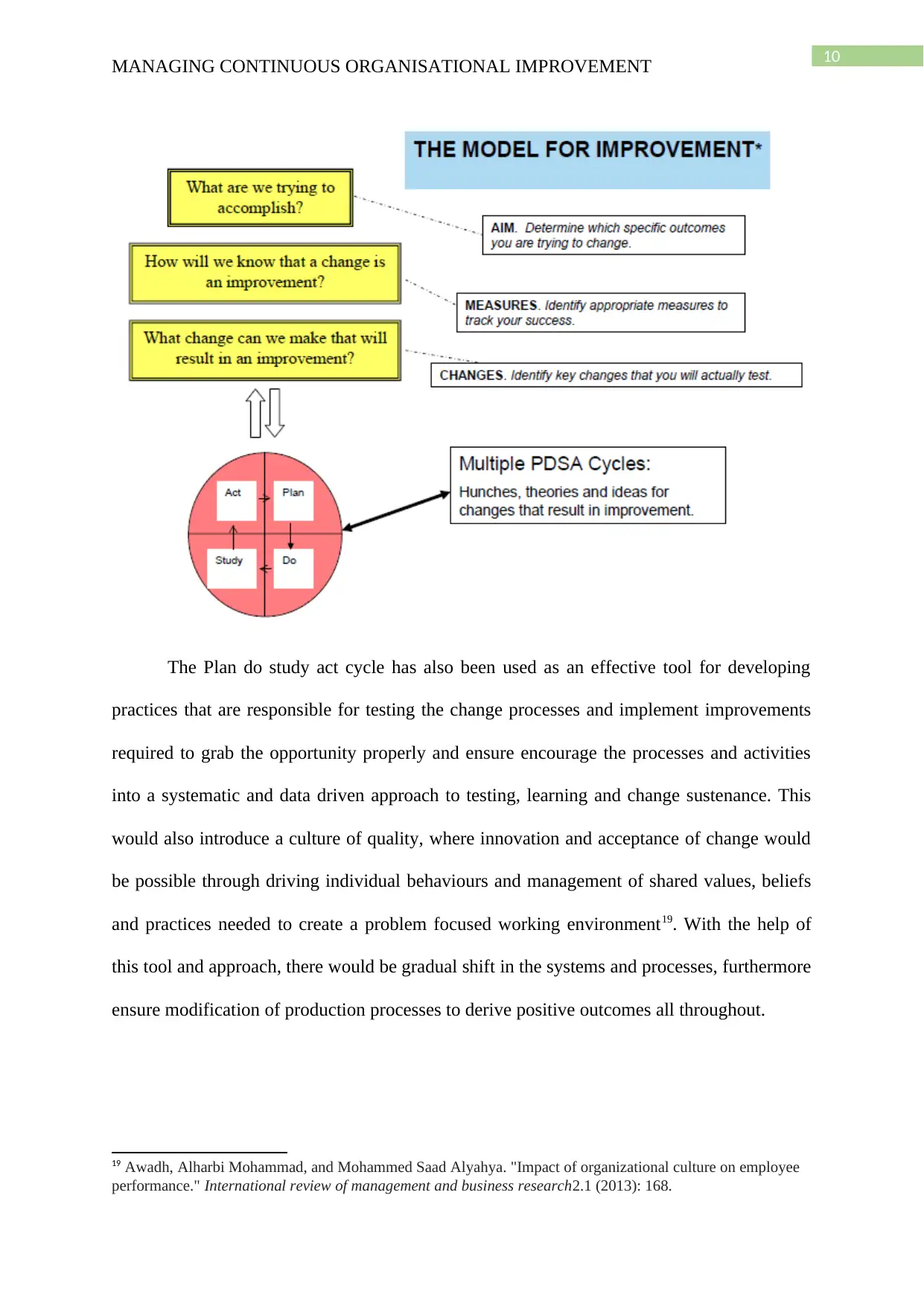
10
MANAGING CONTINUOUS ORGANISATIONAL IMPROVEMENT
The Plan do study act cycle has also been used as an effective tool for developing
practices that are responsible for testing the change processes and implement improvements
required to grab the opportunity properly and ensure encourage the processes and activities
into a systematic and data driven approach to testing, learning and change sustenance. This
would also introduce a culture of quality, where innovation and acceptance of change would
be possible through driving individual behaviours and management of shared values, beliefs
and practices needed to create a problem focused working environment19. With the help of
this tool and approach, there would be gradual shift in the systems and processes, furthermore
ensure modification of production processes to derive positive outcomes all throughout.
19 Awadh, Alharbi Mohammad, and Mohammed Saad Alyahya. "Impact of organizational culture on employee
performance." International review of management and business research2.1 (2013): 168.
MANAGING CONTINUOUS ORGANISATIONAL IMPROVEMENT
The Plan do study act cycle has also been used as an effective tool for developing
practices that are responsible for testing the change processes and implement improvements
required to grab the opportunity properly and ensure encourage the processes and activities
into a systematic and data driven approach to testing, learning and change sustenance. This
would also introduce a culture of quality, where innovation and acceptance of change would
be possible through driving individual behaviours and management of shared values, beliefs
and practices needed to create a problem focused working environment19. With the help of
this tool and approach, there would be gradual shift in the systems and processes, furthermore
ensure modification of production processes to derive positive outcomes all throughout.
19 Awadh, Alharbi Mohammad, and Mohammed Saad Alyahya. "Impact of organizational culture on employee
performance." International review of management and business research2.1 (2013): 168.
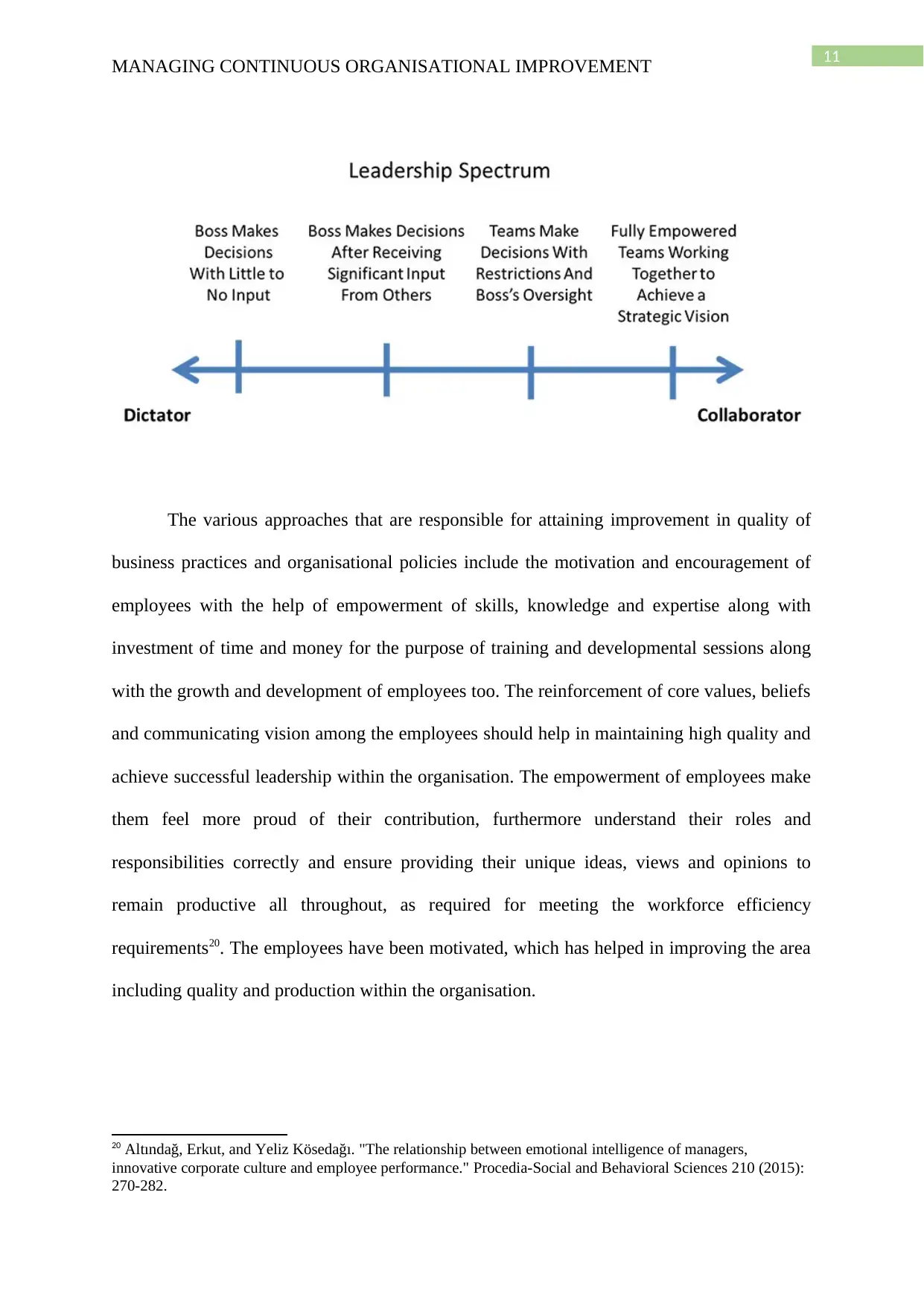
11
MANAGING CONTINUOUS ORGANISATIONAL IMPROVEMENT
The various approaches that are responsible for attaining improvement in quality of
business practices and organisational policies include the motivation and encouragement of
employees with the help of empowerment of skills, knowledge and expertise along with
investment of time and money for the purpose of training and developmental sessions along
with the growth and development of employees too. The reinforcement of core values, beliefs
and communicating vision among the employees should help in maintaining high quality and
achieve successful leadership within the organisation. The empowerment of employees make
them feel more proud of their contribution, furthermore understand their roles and
responsibilities correctly and ensure providing their unique ideas, views and opinions to
remain productive all throughout, as required for meeting the workforce efficiency
requirements20. The employees have been motivated, which has helped in improving the area
including quality and production within the organisation.
20 Altındağ, Erkut, and Yeliz Kösedağı. "The relationship between emotional intelligence of managers,
innovative corporate culture and employee performance." Procedia-Social and Behavioral Sciences 210 (2015):
270-282.
MANAGING CONTINUOUS ORGANISATIONAL IMPROVEMENT
The various approaches that are responsible for attaining improvement in quality of
business practices and organisational policies include the motivation and encouragement of
employees with the help of empowerment of skills, knowledge and expertise along with
investment of time and money for the purpose of training and developmental sessions along
with the growth and development of employees too. The reinforcement of core values, beliefs
and communicating vision among the employees should help in maintaining high quality and
achieve successful leadership within the organisation. The empowerment of employees make
them feel more proud of their contribution, furthermore understand their roles and
responsibilities correctly and ensure providing their unique ideas, views and opinions to
remain productive all throughout, as required for meeting the workforce efficiency
requirements20. The employees have been motivated, which has helped in improving the area
including quality and production within the organisation.
20 Altındağ, Erkut, and Yeliz Kösedağı. "The relationship between emotional intelligence of managers,
innovative corporate culture and employee performance." Procedia-Social and Behavioral Sciences 210 (2015):
270-282.
⊘ This is a preview!⊘
Do you want full access?
Subscribe today to unlock all pages.

Trusted by 1+ million students worldwide
1 out of 24
Related Documents
Your All-in-One AI-Powered Toolkit for Academic Success.
+13062052269
info@desklib.com
Available 24*7 on WhatsApp / Email
![[object Object]](/_next/static/media/star-bottom.7253800d.svg)
Unlock your academic potential
Copyright © 2020–2025 A2Z Services. All Rights Reserved. Developed and managed by ZUCOL.





